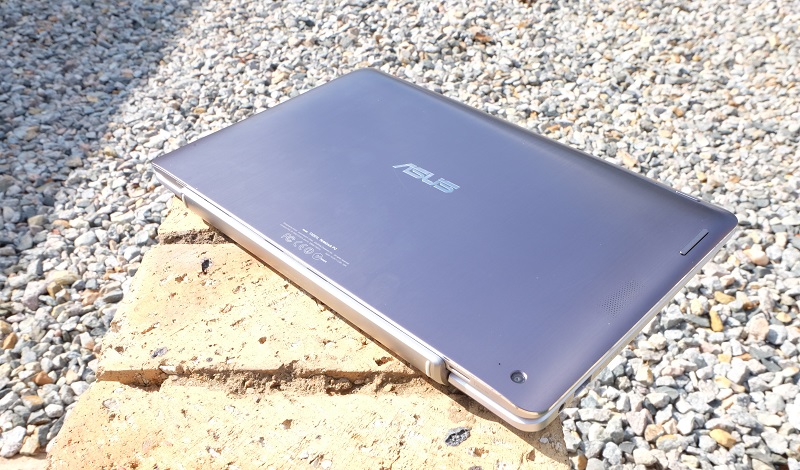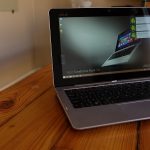The ASUS Transformer Book Trio is perhaps the most innovative detachable notebook ever created. It marries an Android tablet to a Windows 8 notebook, creating a delightfully appealing Franken-tablet hybrid. Each has its own processor, RAM and storage to operate independently, but using some software trickery they can also act in harmony.
The question is: can ASUS’ experiment delight or will it elicit an angry villagers weilding torches and pitchforks? Let’s see.
Caveat: We managed to get our hands on a pre-production model to test out. While the review sheds light on what the final product should be like, there may well be some optimisations before it gets to market.
The Tablet
Design
Given ASUS’ history of making beautiful hybrids, like the rest of its Transformer range, we were pleased to see that it had not failed with the execution of the Transformer Book Trio’s design. Three of the tablet’s four sides are devoid of blemishes and ports, tapering off to a leading edge of svelte aluminium, giving the illusion of a much thinner device than it truly is. All of the ports have been banished to the fourth ‘fatter’ edge of the tablet, its bottom. Here, there is a microSD card slot for expanding the internal storage, a headphone jack, and microUSB port – all flanking a proprietary connector used for connecting it to the laptop base.
Software
The tablet portion of the Transformer Book Trio runs Google’s Android OS exclusively, with very few customisations to bog the system down. There are a few ASUS installed bloatware apps but none are intrusive or meant to replace the standard Android defaults.
Hardware
The tablet runs an Intel Atom (codename Clovertrail+) processor which, while only being a dual core 1.8GHz unit, manages to be exceptionally quick when scrolling through menus and navigating apps. Switching between apps is fluid, with very little stutter noticeable, due, in part, to the 2GB of RAM inside.
Display
The display is an 11.6-inch full HD display which has roughly a 2cm bezel on all sides, giving you ample room to place your hands when you’re using it as a tablet. I say hands because you’re going to need both of them to control the unwieldy beast that is the Transformer Book Trio. While the 16:9 aspect ratio makes it perfect for watching full screen movies, there is simply too much tablet to hold comfortably with one hand in landscape view. Meanwhile, holding it in portrait makes it feel comically tall.
The PC Station
Design
The PC Station (PCS) is essentially a laptop without a display. It has the same style island style keyboard as an ASUS Zenbook but lacks the backlit keys that make them great. There are two USB 3.0 ports on offer as well as a micro HDMI port and a mini display port for connecting additional monitors. Like the tablet, the bottom construction of the PCS is made of aluminium, but unfortunately that’s absent on the top half where the keyboard resides. It cheapens what is otherwise a very premium experience.
Software
The Transformer Book Trio PCS runs Windows 8, which has some pre-installed bloatware of its own. A most useful bit of software, though, is the ASUS Console, which launches a full screen options menu that lets you customise how the Franken-tablet behaves when docked. It’s also possible to designate which folders should be shared between the two, or whether the PC station should sacrifice its battery life for the longevity of the tablet. It’s even possible to sync the last-view webpage on either device. ASUS Console is powerful bit of software and really brings the Android and Windows experiences together.
Hardware
The Transformer Book Trio’s PC component is powered by Intel’s latest and greatest generation of Core i processors (codenamed Haswell) which, in theory, should give it substantially longer battery life than models with a previous generation processor. Our review unit came outfitted with a dual core Intel Core i7 with 4GB of RAM as well as a 500GB storage drive which puts it on par with many Ultrabooks we see offered today.
The Complete Package
Performance
The PCS suffered from a strange problem that saw both the CPU and the disk usage ramp up to 100% load, without anything particularly strenuous being run on it. This immediately made the fans kick in, and it ended up sounding like the cabin of a plane that was about to take off. It also managed to stall the PCS from being able to do anything for a few seconds while waiting for the system to right itself. There is also a program called TrioSambaSend which we understand to be the method by which the files from the Windows and Android system (it uses the open source Samba software that is used for Windows/Linux file server interoperability). It keeps the files you have elected to share synchronised but it keeps popping up a window which then stays open on top of every other application and gets in the way of doing work. As we said earlier this is a pre-production model and we suspect that issues like these will be sorted before the units go on sale. A case could be made that document sharing should be a manual affair and this software workaround has added an unnecessary layer of intricacy to what is already a complicated machine.
Aside from these issues the Transformer Book Trio performed admirably. A standard work day consisting of a dozen or so open tabs in Chrome, multiple chat applications and productivity software all ran smoothly. Gaming almost instantly set the system fans into overdrive, but games like Dota 2 ran without any incident.
Battery Life
Unfortunately we couldn’t get an effective measure on battery life because of the CPU misbehaving. Similar notebooks with Haswell chips offer fantastic battery life, and we suspect that the PCS should offer the same sort of battery life as its contemporaries. ASUS claims around 8 hours of average usage for the PCS and another 8 hours of battery life for the tablet on its own. Combined, the Trio should see 8 hours of battery life in Windows, and 13 hours in Android notebook mode. The tablet can cannibalise battery from the PCS while docked but the reverse doesn’t hold true.
Conclusion
The Transformer Book Trio is an ambitious project. It aims to combine the massive catalogue of Android applications with the equally massive catalogue of traditional Windows applications, giving users the choice between two great operating systems depending on the task required.
The problem is that it’s not spectacular at either. As a tablet it’s too big and unwieldy, giving you an awkward tablet experience that is adequate but never truly great. As an Ultrabook it’s too thick and cumbersome to compete with bespoke notebooks that are single-use only.
But who cares? It’s a single convergent device that manages to get a tablet and Notebook in the same package and working together as one device. It gives you the freedom of Google’s lightweight Android OS for when you need to answer mail or watch a movie in bed, and the power of full-blown Windows desktop for when you need to do something serious, like photo editing. If ASUS can work out the bugs we found in our test unit then the Transformer Book Trio has the potential to be truly brilliant.
The best part of the Transformer Book Trio, though, is its price. The i5 model has an RRP of R12 999 and the i7 version should retail for R14 999 – both options being far cheaper than buying a comparative Ultrabook and tablet separately.




